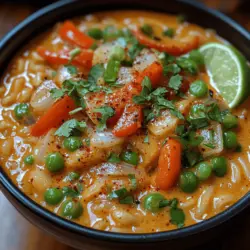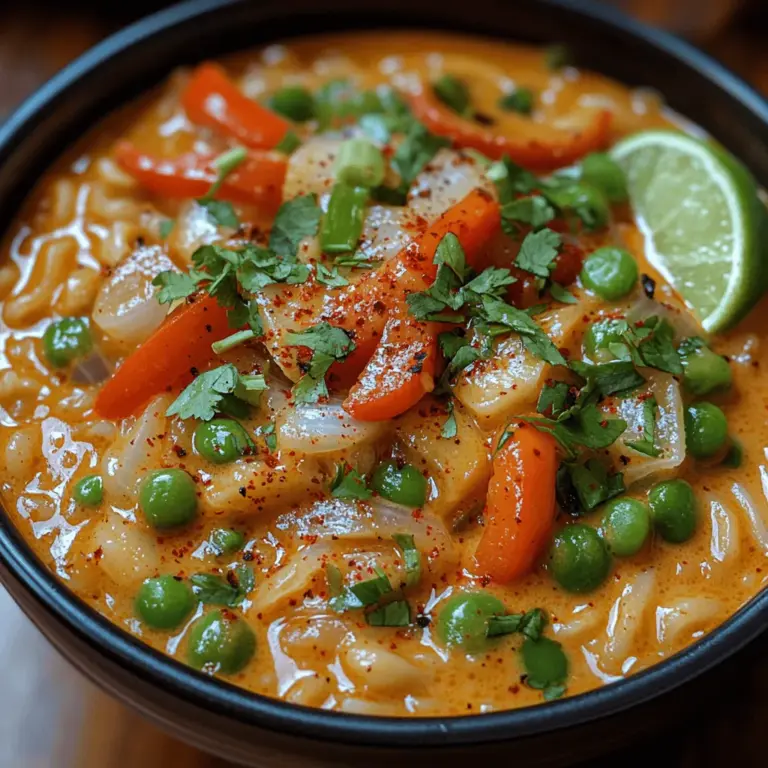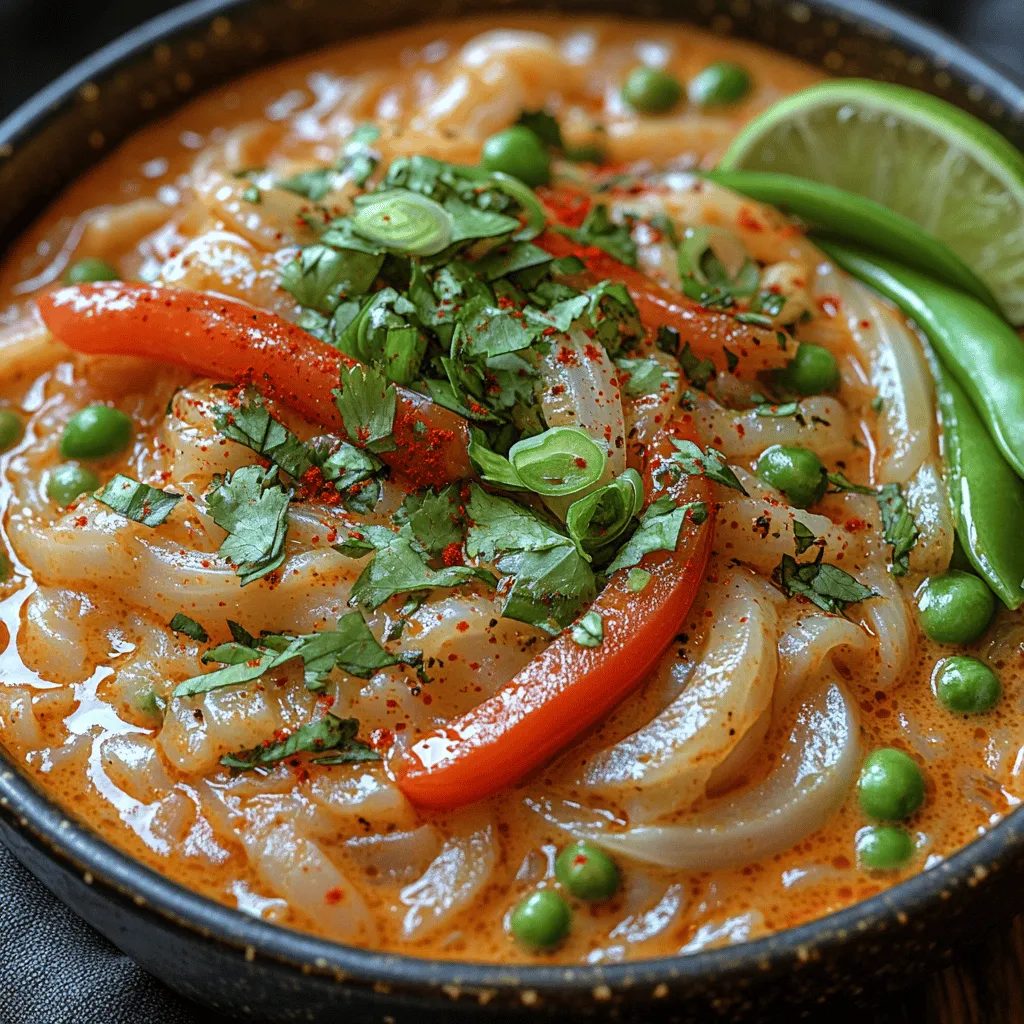Introduction
Silky Thai Coconut Curry Noodles is a dish that embodies the rich flavors and vibrant culture of Southeast Asian cuisine. This delicately balanced meal combines the creaminess of coconut milk with aromatic spices and fresh herbs, creating a comforting yet exotic experience that tantalizes the taste buds. Whether you’re a seasoned chef or a novice in the kitchen, the allure of this dish lies in its simplicity and versatility. It can easily be tailored to suit various dietary preferences, making it a favorite among food enthusiasts around the globe.
The significance of this recipe transcends borders, as Thai cuisine has gained immense popularity worldwide. Rooted in a long tradition of balancing sweet, salty, sour, and spicy elements, this dish reflects the essence of Thai cooking. The harmony of flavors not only makes it a delightful meal but also showcases the cultural importance of food in bringing people together. Sharing a bowl of Silky Thai Coconut Curry Noodles can create bonds among friends and family, fostering a sense of community and celebration.
What makes this dish particularly appealing is its adaptability. You can incorporate a variety of vegetables, proteins, or noodles based on your preferences or what you have on hand. Additionally, the ease of preparation means you can whip up a delicious meal in under 30 minutes, making it perfect for busy weeknights or casual gatherings. Whether you enjoy it as a hearty main course or a light side dish, Silky Thai Coconut Curry Noodles is sure to impress.
Understanding the Ingredients
To create the perfect bowl of Silky Thai Coconut Curry Noodles, understanding the key ingredients is essential. Each component plays a significant role in building the dish’s signature flavor profile, contributing to its irresistible taste and nutritional value.
Primary Ingredients
1. Coconut Milk: The star ingredient of this recipe, coconut milk, adds creaminess and a subtle sweetness that balances the spices. It is rich in healthy fats, particularly medium-chain triglycerides (MCTs), which can provide a quick source of energy and may support weight management.
2. Thai Red Curry Paste: This flavorful blend of red chilies, garlic, lemongrass, galangal, and other spices brings depth to the dish. It provides a kick of heat while also enhancing the overall complexity of flavors. Red curry paste is often rich in antioxidants, making it a nutritious addition.
3. Noodles: Rice noodles are typically used in this recipe, offering a gluten-free option that pairs well with the sauce. They are light and absorb the flavors beautifully. Other noodle varieties, such as soba or udon, can also be used depending on your preference.
4. Vegetables: Fresh vegetables like bell peppers, carrots, and snap peas not only add color but also provide essential vitamins and minerals. Incorporating a variety of veggies contributes to the dish’s nutritional profile, ensuring a well-rounded meal.
5. Protein: Options such as tofu, chicken, shrimp, or beef can be added to make the dish more filling. Tofu is an excellent source of plant-based protein, while lean meats provide essential amino acids.
Nutritional Benefits
The combination of these ingredients not only results in a delicious meal but also offers a range of health benefits. Coconut milk is known for its anti-inflammatory properties, while red curry paste can boost metabolism due to its chili content. The vegetables contribute fiber, vitamins, and minerals, promoting overall health.
Optional Ingredients for Customization
One of the best aspects of Silky Thai Coconut Curry Noodles is its adaptability. Here are some optional ingredients you can include to customize your dish:
– Mushrooms: Add depth and umami flavor while boosting the nutritional value with antioxidants.
– Spinach or Kale: Incorporating leafy greens enhances the dish’s nutrient density and provides additional textures.
– Peanut Butter: For a richer flavor and creaminess, a spoonful of peanut butter can be stirred into the sauce.
– Lime Juice: A squeeze of fresh lime juice at the end brightens the dish and adds a refreshing tartness.
Variations Based on Dietary Preferences
This recipe can easily accommodate various dietary needs. For a vegan option, simply use vegetable broth and tofu or chickpeas as your protein source. If you’re gluten-sensitive, ensure you select gluten-free noodles and check the curry paste ingredients. The flexibility of this dish makes it accessible to all, encouraging experimentation and creativity in the kitchen.
Preparation Techniques
The success of your Silky Thai Coconut Curry Noodles lies not only in the ingredients but also in the preparation techniques. Properly preparing your components can enhance the flavors and ensure a smooth cooking process.
Importance of Preparation Techniques in Cooking
Preparation is crucial for any recipe, especially one that involves multiple ingredients. Taking the time to chop, marinate, and measure before starting to cook can save you from last-minute stress and ensure that everything goes smoothly. A well-prepared kitchen allows for better focus on the cooking process, leading to a more enjoyable experience.
Step-by-Step Guide on Preparing Ingredients
1. Chopping Vegetables: Begin by washing and peeling your vegetables. Slice bell peppers into thin strips, julienne the carrots, and trim the snap peas. Aim for uniform sizes to ensure even cooking.
2. Marinating Protein: If you are using chicken, shrimp, or tofu, consider marinating it in a mixture of soy sauce, lime juice, and a little curry paste for 15-30 minutes. This step adds flavor and tenderness to your protein.
3. Measuring Out Ingredients: Before you start cooking, measure out your coconut milk, curry paste, and any other ingredients. This will make it easier to add them at the appropriate times without fumbling through your pantry.
Chopping, Marinating, or Seasoning Tips
– Knife Skills: Invest time in honing your knife skills. A sharp knife and proper technique will make chopping faster and safer.
– Flavor Infusion: When marinating proteins, allow enough time for the flavors to penetrate. If you’re short on time, even a quick 10-minute marinade can enhance the taste.
– Seasoning: Don’t be afraid to taste as you go. Adjusting seasoning at different stages of cooking ensures a balanced flavor.
Tools and Equipment Needed for the Recipe
To prepare your Silky Thai Coconut Curry Noodles efficiently, gather the following tools:
– Cutting Board: A sturdy surface for chopping your ingredients.
– Sharp Knife: Essential for precise cutting.
– Wok or Large Skillet: A wide pan helps distribute heat evenly and allows for easy stirring.
– Measuring Cups and Spoons: For accurate ingredient portions.
– Serving Bowls: To serve your delicious creation.
Essential Kitchen Tools to Have on Hand
Having the right kitchen tools makes cooking more efficient and enjoyable. In addition to the basic items listed above, consider adding the following to your kitchen arsenal:
– Mandoline Slicer: For uniform vegetable slicing.
– Spatula: A good silicone or wooden spatula helps in stirring without damaging your cookware.
– Ladle: Useful for serving soup-like dishes.
– Tongs: Great for flipping proteins or tossing noodles.
Cooking Process
Once your ingredients are prepped and your kitchen is equipped, it’s time to dive into the cooking process. This section will break down the steps to create the perfect Silky Thai Coconut Curry Noodles.
Detailed Cooking Instructions
1. Sauté Aromatics: Begin by heating a tablespoon of oil in your wok or skillet over medium heat. Add minced garlic and chopped shallots (or onion) to the pan, stirring until fragrant and translucent, about 2-3 minutes.
2. Add Curry Paste: Next, add your red curry paste to the pan. Stir it into the aromatics, allowing it to cook for another minute. This step helps to release the essential oils in the spices, maximizing flavor.
3. Create the Sauce: Pour in the coconut milk, stirring well to combine with the curry paste. Allow the mixture to simmer for 5-7 minutes, letting the flavors meld together. If you prefer a thinner sauce, you can add some vegetable broth or water at this stage.
4. Incorporate Vegetables: Add your prepared vegetables to the sauce, starting with the firmer ones like carrots and bell peppers. Cook for 2-3 minutes before adding the snap peas, which require less time to cook.
5. Cook the Protein: If you’re using marinated chicken or shrimp, add it to the pan now. Cook until the protein is fully cooked through, which should take about 5-7 minutes for chicken and 3-4 minutes for shrimp.
6. Combine with Noodles: Once the protein is cooked, add your cooked rice noodles to the pan. Toss everything together gently to ensure the noodles are well coated in the creamy sauce. Allow the dish to heat through for another minute.
Breaking Down the Cooking Steps
Each step in the cooking process contributes to the development of flavors and textures. It’s essential to pay attention to timing and temperature during each phase to avoid overcooking the vegetables or protein.
Tips for Achieving the Perfect Texture and Flavor
– Taste as You Cook: Adjust seasonings as needed. You may want to add a dash of soy sauce for saltiness or a pinch of sugar to balance the heat.
– Texture: For a satisfying bite, ensure your vegetables remain slightly crisp. Overcooking can lead to mushy textures.
Timing and Temperature Recommendations
Maintaining the right temperature is crucial. Start with medium heat for sautéing aromatics and gradually adjust to medium-high when adding the curry paste. When simmering the sauce, lower the heat to maintain a gentle boil without burning.
Common Pitfalls to Avoid
– Burning Aromatics: Keep an eye on your garlic and shallots. They can go from golden to burnt quickly.
– Overcooking Protein: Chicken should be cooked until no longer pink, while shrimp should be opaque and curled.
– Too Thick Sauce: If your sauce becomes too thick, add a splash of water or broth to achieve the desired consistency.
Potential Mistakes and How to Fix Them
If you find your dish lacking flavor, try adding a splash of lime juice or an extra spoonful of curry paste. If it’s too spicy, balance it out with a bit more coconut milk or sugar. Should you oversalt, adding a bit of unsweetened coconut milk can help mellow the saltiness.
By following these steps and tips, you’ll be well on your way to mastering the art of Silky Thai Coconut Curry Noodles. Each bowl will not only taste incredible but will also reflect the vibrant and diverse culinary heritage of Thailand. In the next part of this recipe article, we will delve deeper into finishing touches, garnishing ideas, and serving suggestions to elevate your dish further.
Serving Suggestions
Plating and presentation can elevate a dish from ordinary to extraordinary. For your Silky Thai Coconut Curry Noodles, consider using a large, shallow bowl to showcase the vibrant colors of the curry sauce and noodles. Start by placing a generous serving of noodles at the center of the bowl, allowing them to cascade slightly over the edges for an inviting look.
When garnishing this dish, fresh herbs are essential. Finely chop cilantro and sprinkle it liberally over the top to add a burst of color and flavor. For a crunchy element, consider adding a handful of toasted peanuts or cashews. They not only provide texture but also enhance the nutty undertones of the coconut milk. A drizzle of lime juice just before serving will add brightness, while thin slices of red chili can introduce a pop of color and heat.
To complement your Silky Thai Coconut Curry Noodles, side dishes such as a light cucumber salad or a spicy Thai papaya salad (som tam) work beautifully. These dishes add a refreshing crunch and contrast to the creamy noodles. For beverages, a cold Thai iced tea or a light lager can enhance your dining experience. If you prefer non-alcoholic options, consider coconut water or a refreshing limeade.
Storage and Reheating Tips
Proper storage is crucial to maintaining the quality of your Silky Thai Coconut Curry Noodles. If you have leftovers, transfer them to an airtight container and store them in the refrigerator. Ideally, consume the dish within 3 to 5 days for the best taste and freshness. If you wish to keep the dish for longer, consider freezing the noodles and sauce separately. This will preserve the texture and flavor, allowing you to enjoy the dish later.
To reheat your noodles, you have a couple of options. The microwave is a quick and convenient method. Place your noodles in a microwave-safe dish, cover them with a damp paper towel, and heat them in 30-second intervals, stirring in between until heated through. However, if you want to maintain the integrity of the noodles and sauce, reheating them on the stovetop may be preferable. Simply add a splash of coconut milk or vegetable broth to a skillet, and heat the noodles over medium-low heat, stirring gently until warmed.
Avoid reheating the dish multiple times, as this can lead to a loss of flavor and texture. Aim to reheat only the portion you plan to consume.
Nutritional Information
Understanding the nutritional content of your Silky Thai Coconut Curry Noodles can help you appreciate the health benefits of this delicious meal. A typical serving (about 1 cup) contains approximately 350-400 calories, depending on the specific ingredients used and portion sizes.
In terms of macronutrients, you can expect:
– Carbohydrates: 50-60 grams, primarily from the noodles and vegetables.
– Protein: 12-15 grams, which can be increased by adding tofu, chicken, or shrimp.
– Fat: 15-20 grams, mostly from the coconut milk and any nuts used in garnishing.
This dish is rich in vitamins and minerals, including Vitamin C from the lime and vegetables, potassium from the coconut milk, and antioxidants from the herbs and spices. Regular consumption of coconut and vegetables in your diet can contribute to improved heart health, better digestion, and enhanced skin health thanks to the healthy fats and nutrients present in these ingredients.
Cultural Significance and Variations
Silky Thai Coconut Curry Noodles are not just a meal; they carry a rich cultural history rooted in Thai cuisine. Coconut milk, a staple in Southeast Asian cooking, has been used for centuries due to its creamy texture and unique flavor profile. The use of noodles in Thai dishes dates back to ancient times, influenced by trade with neighboring countries and the integration of various culinary techniques.
Over the years, variations of this dish have emerged across different regions of Thailand. For instance, in Northern Thailand, you might find a version incorporating local herbs and spices, while Southern Thai cuisine often features more seafood variations, reflecting the region’s coastal geography. Each variation brings a unique twist to the original recipe, allowing for creativity and personal touches based on local ingredients and preferences.
Outside of Thailand, many cultures have adopted and adapted this dish. In Western countries, you may find it made with whole wheat or gluten-free noodles, catering to dietary preferences while maintaining the essence of the original flavors. Fusion recipes also abound, combining elements from other cuisines, such as adding Italian herbs or using Mexican spices to create a completely new experience.
Conclusion
Silky Thai Coconut Curry Noodles are a celebration of flavor, color, and culture. This dish not only satisfies the palate but also invites exploration and creativity in the kitchen. Its versatility allows you to customize it according to your taste preferences and dietary needs, making it a perfect meal for any occasion.
Whether you are enjoying a quiet dinner at home or hosting a gathering with friends and family, this recipe promises to impress. So, gather your ingredients, unleash your inner chef, and savor the joy of cooking and sharing this delightful dish with loved ones. Each bowl of Silky Thai Coconut Curry Noodles is a reminder of the warmth and connection that comes from preparing and sharing food, making it a cherished addition to your culinary repertoire.


